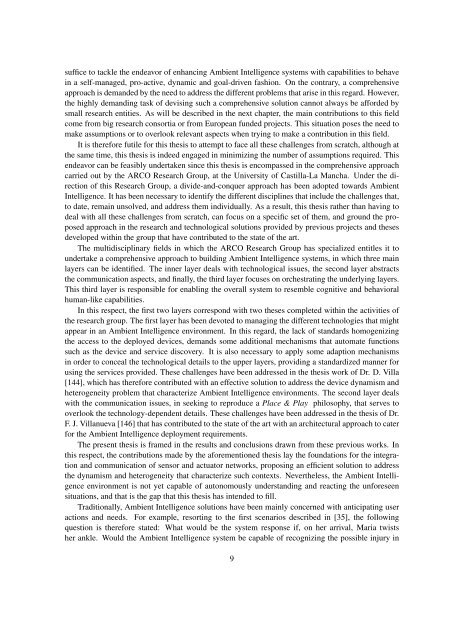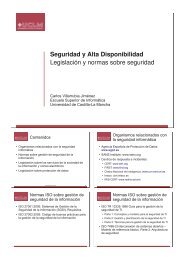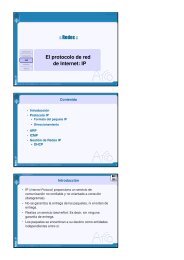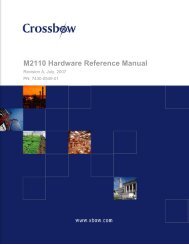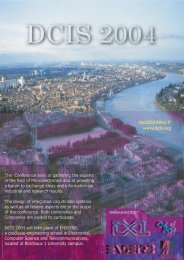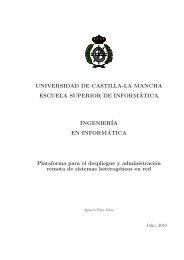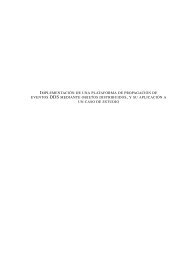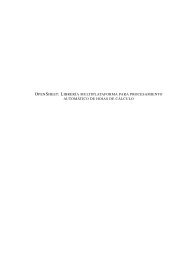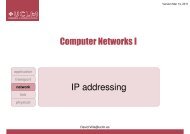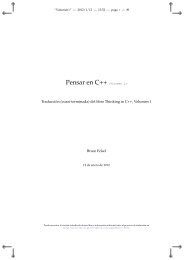and events, and the mechanisms to resemble human-like common-sense knowledge and reasoningcapabilities.From the cognitive perspective, the problem can be addressed as an un<strong>de</strong>rstanding problem. Comprehendinga situation that takes place in a context might involve, for example, the inference of implicit,non-<strong>de</strong>terministic or <strong>de</strong>layed effects. A <strong>de</strong>layed effect of turning on a tap in a kitchen sinkwhose plug is in place, will be a water overflow. From a behavioral perspective, the problem can beaddressed as a planning problem of <strong>de</strong>ciding what action to take in certain given circumstances. Acommon-sense strategy for planning and un<strong>de</strong>rstanding, such as that presented in [150] would, therefore,appear to be the most compelling approach towards emulating the human-like rationality andreasoning capability.Finally, the last challenge that should be faced when building systems for Ambient Intelligenceis that of addressing novelty. It has to be noted that unexpected situations, which in words of DougLenat et al. [80] suppose the bottleneck of intelligent systems, are the most common situations foundin Ambient Intelligence contexts. The way in which people react to these unexpected situationsprovi<strong>de</strong>s an i<strong>de</strong>a of the direction in which efforts should be addressed. Generally, when facing newsituations, people tend to establish some similarities with past experiences, or resort to their generalknowledge of how things work, the so-called common-sense knowledge, or even look for advicein books. Whatever the case may be, it is axiomatic for this thesis that only Ambient Intelligencesystems will be sufficiently flexible to support the scenarios envisioned in [35] when common-sensereasoning starts being consi<strong>de</strong>red as a structural part of such systems. In this sense, the associatedworking hypothesis is that un<strong>de</strong>rstanding and mo<strong>de</strong>ling common-sense reasoning, in such a way thatit can be automatically performed, is a key challenge that, once achieved, would allow systems forAmbient Intelligence to be in<strong>de</strong>ed intelligent.At this point, the main axioms and working hypotheses of this work have been roughly outlined,providing an overall view of the main challenges faced when building systems for Ambient Intelligence.The following sections will address with higher levels of <strong>de</strong>tail, the fundamental problemsthat have motivated this work. The third section will present the aims and objectives of this thesis.While the main contributions are presented in section four. Finally, the last section presents a brief<strong>de</strong>scription of the content addressed in each of the consecutive chapters that follow this chapter.1.2 MotivationThe previous section has pointed out some of the main challenges that need to be addressed whenbuilding systems for Ambient Intelligence. These challenges are also consi<strong>de</strong>red to be part of themain concerns that have motivated this thesis. However, for the sake of precision, this section simplysynthesizes these general aspects by providing a list of intentions, which will be addressed with more<strong>de</strong>tail in the following chapters. These intentions establish the directions towards which efforts needto be directed in or<strong>de</strong>r to achieve the ultimate goal of building systems for Ambient Intelligence.In this regard, the main peculiarity which distinguishes Ambient Intelligence from other fields ofknowledge is the interdisciplinarity of the challenges faced. This interdisciplinarity therefore involvesspecialization in a wi<strong>de</strong> variety of technologies, thus turning the task of building comprehensiveapproaches to Ambient Intelligence into a very complex en<strong>de</strong>avor that requires knowledge of a wi<strong>de</strong>range of technologies.Augusto et al. enumerate in [8] some of the main technologies that are encompassed in AmbientIntelligence. As stated by these authors, building systems for Ambient Intelligence is a task thatrequires a certain level of expertise in fields such as Sensor Networks, Artificial Intelligence, or Multi-Agent Systems among others. The adoption of an approach based on a single technology does not8
suffice to tackle the en<strong>de</strong>avor of enhancing Ambient Intelligence systems with capabilities to behavein a self-managed, pro-active, dynamic and goal-driven fashion. On the contrary, a comprehensiveapproach is <strong>de</strong>man<strong>de</strong>d by the need to address the different problems that arise in this regard. However,the highly <strong>de</strong>manding task of <strong>de</strong>vising such a comprehensive solution cannot always be affor<strong>de</strong>d bysmall research entities. As will be <strong>de</strong>scribed in the next chapter, the main contributions to this fieldcome from big research consortia or from European fun<strong>de</strong>d projects. This situation poses the need tomake assumptions or to overlook relevant aspects when trying to make a contribution in this field.It is therefore futile for this thesis to attempt to face all these challenges from scratch, although atthe same time, this thesis is in<strong>de</strong>ed engaged in minimizing the number of assumptions required. Thisen<strong>de</strong>avor can be feasibly un<strong>de</strong>rtaken since this thesis is encompassed in the comprehensive approachcarried out by the <strong>ARCO</strong> Research Group, at the University of Castilla-La Mancha. Un<strong>de</strong>r the directionof this Research Group, a divi<strong>de</strong>-and-conquer approach has been adopted towards AmbientIntelligence. It has been necessary to i<strong>de</strong>ntify the different disciplines that inclu<strong>de</strong> the challenges that,to date, remain unsolved, and address them individually. As a result, this thesis rather than having to<strong>de</strong>al with all these challenges from scratch, can focus on a specific set of them, and ground the proposedapproach in the research and technological solutions provi<strong>de</strong>d by previous projects and theses<strong>de</strong>veloped within the group that have contributed to the state of the art.The multidisciplinary fields in which the <strong>ARCO</strong> Research Group has specialized entitles it toun<strong>de</strong>rtake a comprehensive approach to building Ambient Intelligence systems, in which three mainlayers can be i<strong>de</strong>ntified. The inner layer <strong>de</strong>als with technological issues, the second layer abstractsthe communication aspects, and finally, the third layer focuses on orchestrating the un<strong>de</strong>rlying layers.This third layer is responsible for enabling the overall system to resemble cognitive and behavioralhuman-like capabilities.In this respect, the first two layers correspond with two theses completed within the activities ofthe research group. The first layer has been <strong>de</strong>voted to managing the different technologies that mightappear in an Ambient Intelligence environment. In this regard, the lack of standards homogenizingthe access to the <strong>de</strong>ployed <strong>de</strong>vices, <strong>de</strong>mands some additional mechanisms that automate functionssuch as the <strong>de</strong>vice and service discovery. It is also necessary to apply some adaption mechanismsin or<strong>de</strong>r to conceal the technological <strong>de</strong>tails to the upper layers, providing a standardized manner forusing the services provi<strong>de</strong>d. These challenges have been addressed in the thesis work of Dr. D. Villa[144], which has therefore contributed with an effective solution to address the <strong>de</strong>vice dynamism andheterogeneity problem that characterize Ambient Intelligence environments. The second layer <strong>de</strong>alswith the communication issues, in seeking to reproduce a Place & Play philosophy, that serves tooverlook the technology-<strong>de</strong>pen<strong>de</strong>nt <strong>de</strong>tails. These challenges have been addressed in the thesis of Dr.F. J. Villanueva [146] that has contributed to the state of the art with an architectural approach to caterfor the Ambient Intelligence <strong>de</strong>ployment requirements.The present thesis is framed in the results and conclusions drawn from these previous works. Inthis respect, the contributions ma<strong>de</strong> by the aforementioned thesis lay the foundations for the integrationand communication of sensor and actuator networks, proposing an efficient solution to addressthe dynamism and heterogeneity that characterize such contexts. Nevertheless, the Ambient Intelligenceenvironment is not yet capable of autonomously un<strong>de</strong>rstanding and reacting the unforeseensituations, and that is the gap that this thesis has inten<strong>de</strong>d to fill.Traditionally, Ambient Intelligence solutions have been mainly concerned with anticipating useractions and needs. For example, resorting to the first scenarios <strong>de</strong>scribed in [35], the followingquestion is therefore stated: What would be the system response if, on her arrival, Maria twistsher ankle. Would the Ambient Intelligence system be capable of recognizing the possible injury in9
- Page 1: DEPARTAMENTO DE TECNOLOGÍAS Y SIST
- Page 4 and 5: María José Santofimia RomeroTelé
- Page 7: ResumenLa Inteligencia Ambiental, p
- Page 11 and 12: ContentsContentsList of TablesList
- Page 13: CONTENTSVII7.4.4 The Plan Executor
- Page 17: List of Figures4.1 Kripke model for
- Page 21: Part IPreliminaries3
- Page 24 and 25: This gap poses an urgent need to de
- Page 28 and 29: Maria’s ankle as an impediment to
- Page 30 and 31: 1.3 Aims and objectivesGiven that t
- Page 32 and 33: The fourth item concerns the way th
- Page 34 and 35: of such goals and desires and how t
- Page 36 and 37: tion, is addressed by coping with a
- Page 38 and 39: networking from being widely spread
- Page 40 and 41: The MERL’s Ambient Intelligence f
- Page 42 and 43: tions come into play. These scenari
- Page 44 and 45: interact with electronic devices, e
- Page 46 and 47: tionally, the middleware architectu
- Page 48 and 49: The idea behind the work proposed h
- Page 50 and 51: esources under a middleware based o
- Page 53: Part IIUnderstanding35
- Page 56 and 57: obvious. In this sense, sociologist
- Page 58 and 59: true throughout a time interval, or
- Page 60 and 61: application domain is (true, false)
- Page 62 and 63: (SubAsbstrac Nathan Nathan2007)(Sub
- Page 64 and 65: Moreover, events not only cannot be
- Page 66 and 67: epresented by means of the notion o
- Page 68 and 69: Context-awareness is one of the mai
- Page 70 and 71: In any case, the adopted behavioral
- Page 72 and 73: when the water level starts increas
- Page 74 and 75: Traditionally, these responses have
- Page 76 and 77:
true.Additionally, the meaning of t
- Page 78 and 79:
(6) Statement → Service-ID perfor
- Page 80 and 81:
the set of possible contexts, and M
- Page 82 and 83:
in which S is a nonempty set of sta
- Page 84 and 85:
are considered possible given the p
- Page 86 and 87:
cope with the demands involved in d
- Page 89 and 90:
Chapter 5Understanding Context Situ
- Page 91 and 92:
Figure 5.1: Overall view of the pro
- Page 93 and 94:
adjusting existing knowledge to sim
- Page 95 and 96:
of some events involves the stateme
- Page 97 and 98:
( new-statement { picker } {is loca
- Page 99 and 100:
The way of determining which after
- Page 101 and 102:
CL-USER > ( the-x-of-y-is-z { enter
- Page 103 and 104:
CL-USER > ( the-only-x-of-y-is-z {
- Page 105 and 106:
CL-USER > ( get-element-fluent ( lo
- Page 107 and 108:
The specificity of the propositiona
- Page 109 and 110:
Following the same dynamic, the dif
- Page 111:
part is intended to propose a solut
- Page 115 and 116:
Chapter 6Behavioral Response Genera
- Page 117 and 118:
and action selection by means of a
- Page 119 and 120:
wants the room to be at a higher te
- Page 121 and 122:
state of the world with those plann
- Page 123 and 124:
conflict. The later strategy requir
- Page 125 and 126:
Function f returns the actions, fro
- Page 127:
next step selected in the plan. The
- Page 130 and 131:
of it. It is also possible to try t
- Page 132 and 133:
Agent System (MAS), individual agen
- Page 134 and 135:
the requirements stated for the BRG
- Page 136 and 137:
The action planning algorithmMaking
- Page 138 and 139:
The advantages underlying service c
- Page 140 and 141:
effects. On the contrary, an approp
- Page 143:
Part IVValidation and discussions12
- Page 146 and 147:
taking place. The interpretation of
- Page 148 and 149:
The key elements of the evaluation
- Page 150 and 151:
also been proved to serve as a mean
- Page 152 and 153:
Table 8.2: Simulation Configuration
- Page 154 and 155:
the knowledge-base, it saves time i
- Page 156 and 157:
effects and the sensed ones leads t
- Page 158 and 159:
Table 8.3: Personal information of
- Page 160 and 161:
Scenario Interpretations Number of
- Page 162 and 163:
understand the terms used to descri
- Page 164 and 165:
Finally, the causal explanation app
- Page 166 and 167:
2. A2: To provide a service composi
- Page 168 and 169:
System has to be motivated by goals
- Page 170 and 171:
een addressed by this thesis. Howev
- Page 173 and 174:
Bibliography[1] Gregory D. Abowd, A
- Page 175 and 176:
[25] Diane J. Cook, Juan C. Augusto
- Page 177 and 178:
[54] Tao Gu, Hung Keng Pung, and Da
- Page 179 and 180:
[83] Clemens Lombriser, Nagendra B.
- Page 181 and 182:
[110] Davy Preuveneers, Jan Van den
- Page 183 and 184:
[134] John F. Sowa. Conceptual Stru
- Page 185:
Part VIAppendix167
- Page 188 and 189:
Ambient Intelligence environment, i
- Page 190 and 191:
invocation. However, in reality the
- Page 192 and 193:
consists in querying the Topic Mana
- Page 194 and 195:
Figure A.4: Multi-Agent System over
- Page 196 and 197:
The result of the planning algorith
- Page 198 and 199:
concepts and relationships are impl
- Page 200 and 201:
As listed below, the recognition ac
- Page 202 and 203:
184Figure A.8: Sequence diagram for
- Page 204 and 205:
}query = " ( b−wire ( car ( list
- Page 207:
Este documento fue editado con GNU


